
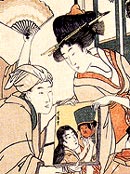
TANAKA Kyôkichi (田中恭吉)
|
 Tanaka Kyôkichi (田中恭吉), born in Wakayama Prefecture, went to Tokyo in 1910 hoping to enroll in the Tokyo School of Fine Arts, but he was unsuccessful with the entrance examination. Meanwhile, he attended the Hakubakai Institute of Western Painting where he studied with Nagahara Kôtarô (長原孝太郎 1864-1930), a yôga (Western-style: 洋画) painter. It was there that he met Fujimori Shizuo and Onchi Kôshirô, with whom he would collaborate on seven issues of their print and poetry magazine magazine Tsukuhae ("Moonglow": 月映), issued from September 1914 until November 1915. Starting around 1912 he also began a close relationship with the artist Takehisa Yumeji (竹久夢二 1884-1934), who was also important in Onchi's development as an artist.
Tanaka Kyôkichi (田中恭吉), born in Wakayama Prefecture, went to Tokyo in 1910 hoping to enroll in the Tokyo School of Fine Arts, but he was unsuccessful with the entrance examination. Meanwhile, he attended the Hakubakai Institute of Western Painting where he studied with Nagahara Kôtarô (長原孝太郎 1864-1930), a yôga (Western-style: 洋画) painter. It was there that he met Fujimori Shizuo and Onchi Kôshirô, with whom he would collaborate on seven issues of their print and poetry magazine magazine Tsukuhae ("Moonglow": 月映), issued from September 1914 until November 1915. Starting around 1912 he also began a close relationship with the artist Takehisa Yumeji (竹久夢二 1884-1934), who was also important in Onchi's development as an artist.
Tanaka tried again to pass the entrance exam for the Tokyo School of Fine Arts, succeeding in 1911, but only after changing the intended course of study from yôga to nihonga (Japanese-style painting: 日本画). Unfortunately, he soon became disillusioned with the required repetitive copying in the course, and so resumed study at the Hakubakai in oil painting. The following year some of his poems were published in Bunshô sekai (World of writing: 文章世界 1906-1920) and in the book Komomo no maki (Red peach), which was the second volume of Yumeji's Sakura saku kuni (Land of blossoming cherries: 櫻さく國).
In 1913 Tanaka contracted tuberculosis. This was around the time when he, Onchi, Fujimori, and others were contributing drawings and poems to the journal Misshitsu (Closed room: 密室). In 1914 Yumeji's publisher Kawamoto Kamenosuke, the proprietor of the Rakuyôdôkan, began issuing the aforementioned Tsukuhae, which before then had been printed in only three impressions for private distribution among the three artists. The name for the magazine was suggested by Tanaka. As his health worsened, he left the Tokyo School of Fine Arts in 1914, returning to Wakayama where, in June, he was told that his illness was terminal. Meanwhile, Onchi and Fujimori continued with their preparations to have Tsukuhae published by the Rakuyôdôkan firm.
 The first woodcut on this page, shown above, is perhaps Tanaka's most famous design. Dated to 1915, it was untitled, but today is known as "Melancholy" (image: 188 x 99 mm). Tanaka knew by this time that he was dying from tuberculosis, which must have had a bearing on what this image meant to him and probably reflected a deeply felt autobiographical significance. "Melancholy" could very well have been an expression of transcendence in the face of illness and death. Blue plumes envelope a fragile naked figure, poised on the tip of a small triangular form at the bottom edge of the picture frame. There is as well a form at the middle top within the blue plume that appears to be an eye. What this watchful element signifies is unclear, but it certainly contributes to an expressiveness that owes something to Western Symbolism, a late nineteenth-century art movement of French, Russian and Belgian origin, which Tanaka would have been familiar with, at least as reproduced in art and poetry periodicals. The magazine Shirakaba ("White Birch," 白樺 1910-1923), for example, had already published a woodcut by the Norwegian Edvard Munch (1863-1944) in its April 1912 issue. Moreover, for two weeks (March 14-28, 1914), there was a showing of German expressionist art (and Cubist and Fauve works as well) at the Hibiya Art Museum in Tokyo, a small private museum that primarily offered a platform for young artists. The exhibition included works by the Brücke artists Erich Heckel, Ernst Ludwig Kirchner, Max Pechstein and Karl Schmidt-Rottluff, plus artists such as Umberto Boccioni, Oskar Kokoschka, Wilhelm Morgner, Robert Storm-Petersen, Hanns Bolz, Arthur Segal and Fernand Leger. A photo survives from the exhibition, seen here above left. It is likely that Tanaka attended the show, although the displayed works might have done no more than confirm to him that other artists had already adopted expressionism as a mode of design. What can be read as the morbid romanticism of the three young friends who designed Tsukuhae was a central motif of the early twentieth-century zeitgeist, when many young Japanese intellectuals, artists, and writers saw themselves as bohemian and decadent.
The first woodcut on this page, shown above, is perhaps Tanaka's most famous design. Dated to 1915, it was untitled, but today is known as "Melancholy" (image: 188 x 99 mm). Tanaka knew by this time that he was dying from tuberculosis, which must have had a bearing on what this image meant to him and probably reflected a deeply felt autobiographical significance. "Melancholy" could very well have been an expression of transcendence in the face of illness and death. Blue plumes envelope a fragile naked figure, poised on the tip of a small triangular form at the bottom edge of the picture frame. There is as well a form at the middle top within the blue plume that appears to be an eye. What this watchful element signifies is unclear, but it certainly contributes to an expressiveness that owes something to Western Symbolism, a late nineteenth-century art movement of French, Russian and Belgian origin, which Tanaka would have been familiar with, at least as reproduced in art and poetry periodicals. The magazine Shirakaba ("White Birch," 白樺 1910-1923), for example, had already published a woodcut by the Norwegian Edvard Munch (1863-1944) in its April 1912 issue. Moreover, for two weeks (March 14-28, 1914), there was a showing of German expressionist art (and Cubist and Fauve works as well) at the Hibiya Art Museum in Tokyo, a small private museum that primarily offered a platform for young artists. The exhibition included works by the Brücke artists Erich Heckel, Ernst Ludwig Kirchner, Max Pechstein and Karl Schmidt-Rottluff, plus artists such as Umberto Boccioni, Oskar Kokoschka, Wilhelm Morgner, Robert Storm-Petersen, Hanns Bolz, Arthur Segal and Fernand Leger. A photo survives from the exhibition, seen here above left. It is likely that Tanaka attended the show, although the displayed works might have done no more than confirm to him that other artists had already adopted expressionism as a mode of design. What can be read as the morbid romanticism of the three young friends who designed Tsukuhae was a central motif of the early twentieth-century zeitgeist, when many young Japanese intellectuals, artists, and writers saw themselves as bohemian and decadent.
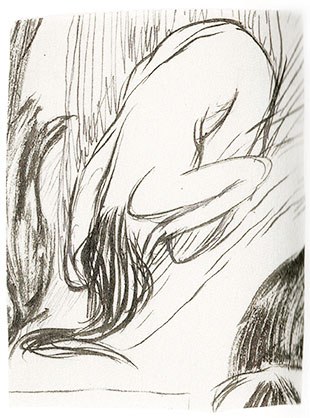 |
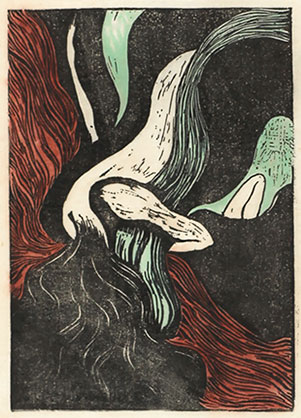 |
| Tanaka: Untitled [Leaning over], pen and ink sketch Image: 109 x 82 mm; 1914 |
Tanaka: Untitled [Leaning over], woodcut, 1914 Image: 190 x 133 mm; 1914 |
The influence of European Symbolism and Expressionism can be found in the images shown immediately above. Untitled, the design has been given several provisional titles, including "Woman leaning over" (伏す女), "Bending down," and "Washing hair." Above left is an ink-on-paper sketch that seems to qualify as a preliminary or related study, and the finished print is above right. As with the design for "Melancholy," the red band of wave-lines might suggest the flow of life as well as the existential current that pulls us toward death. Certainly, if we allow Tanaka's biography to intrude upon our interpretation, this would be a plausible reading. As for the more prosaic suggestion that this image depicts a woman washing her hair, it is not an impossible theme for the image, but remains too narrow and unsatisfying a conception. For one thing, the red coloration shifts the discourse toward a metaphysical "washing," a cleansing of the soul before the end of life. In that sense, the design would once again be concerned with death and transcendence.
 The iconoclastic free-verse poet Hagiwara Sakutarô (萩原 朔太郎 1886-1942) was much affected by Tanaka's prints, seeing in them both a positive life-force and a terrifying reality (the latter, no doubt, reflective of Tanaka's serious illness). In the spring of 1915, Hagiwara asked Tanaka to provide illustrations for his first anthology of poems, the seminal, self-published Tsuki ni hoeru (Howling at the moon: 月に吠える). Tanaka was too ill to carve new designs or print older ones, so he sent drawings. (Onchi also provided designs for the volume.) Sadly, Tanaka died on October 23rd, well before Hagiwara's anthology could be published (it was issued in 1917). The image on the right, known as Hikari ("Light": 光), is one of Tanaka's prints, in this instance the cover design for Hagiwara's Tsuki ni hoeru.
The iconoclastic free-verse poet Hagiwara Sakutarô (萩原 朔太郎 1886-1942) was much affected by Tanaka's prints, seeing in them both a positive life-force and a terrifying reality (the latter, no doubt, reflective of Tanaka's serious illness). In the spring of 1915, Hagiwara asked Tanaka to provide illustrations for his first anthology of poems, the seminal, self-published Tsuki ni hoeru (Howling at the moon: 月に吠える). Tanaka was too ill to carve new designs or print older ones, so he sent drawings. (Onchi also provided designs for the volume.) Sadly, Tanaka died on October 23rd, well before Hagiwara's anthology could be published (it was issued in 1917). The image on the right, known as Hikari ("Light": 光), is one of Tanaka's prints, in this instance the cover design for Hagiwara's Tsuki ni hoeru.
Another woodcut in the vein of Surrealist Expressionism is Tanaka's untitled and mysterious portrayal of two figures, one seemingly a dying woman draped in a blue garment or wrapping cloth, with only her head, skeletal left arm and right hand visible. Lying above or upon her is a figure shrouded in black with a blue mask-like face. One title suggested for this compelling and disturbing piece is Nama uru mono saru mono ("A person being born and dying": 生うるもの・去るもの). Another descriptive identification is Shi no shihai-sha no bishô (The smile of the ruler over death: 死の支配者の微笑). Regardless, what seems clear is that it likely expresses Tanaka's struggle with his illness and his angst over whether presaged his death (he had not yet been told that it was terminal).
A design by Tanaka that appeared in Tsukuhae III is shown below. A woman holds what might be piece of clothing (although one could perhaps argue that it is the hair of another figure). Tanaka's familiar wave-lines are used to indicate that form, as well as the woman's shoulders and hair, and the flowing shapes in the top corners. Darkness envelopes the woman and her mouth is obscured as well. Large, heavily lidded eyes suggest sorrow. There is a kinship here between Tanaka's portrayal and several woodcuts depicting embracing or kissing couples by the Edvard Munch, although how far one could take the affinity is difficult to determine. Regardless, the expressive power of the two images shown below is undeniable and compares with the best of European Expressionist art during the 1910s.
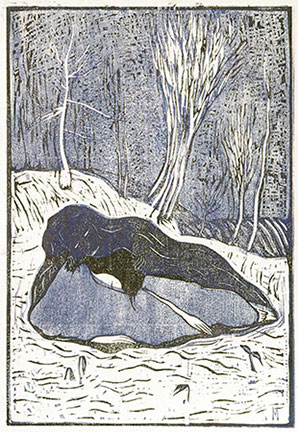 |
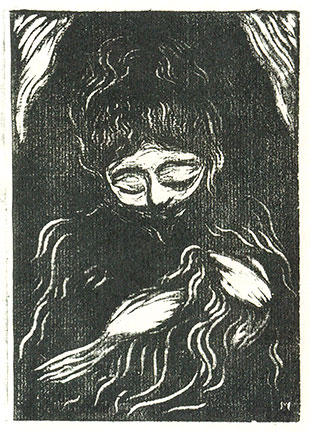 |
| Tanaka: Untitled [Person being born and dying], woodcut (image: 190 x 133 mm); 3/1914 |
Tanaka: Untitled [Woman, 女], from Tsukuhae III |
Two months after Tanaka's death, Onchi and Fujimori mounted a memorial exhibition of his work at Hibiya Hall in Tokyo. Tsukuhae would end after the seventh issue, and Onchi Tanaka's prints from 1914 and 1915 were surely as avant garde and expressionistic as were Onchi's justly celebrated emotive works from the 1910s. For an artist with Tanaka's temperament and visionary abilities to die so young was more than a personal tragedy — it was an incalculable loss for twentieth-century Japanese art. © 2020 by John Fiorillo
BIBLIOGRAPHY
- Ajioka, Chiaki, Nishiyama, Chuko, Kuwahara, Noriko: Hanga: Japanese Creative Prints. Sydney: Art Gallery of New South Wales, 2000, pp. 50 and 56.
- Fujii, Hisae: Onchi Kôshirô to Tsukuhae (Onchi Kôshirô and Moonglow: 恩地孝四郎と月映). Tokyo: National Museum of Modern Art, 1976.
- Jenkins, Donald: Images of a Changing World: Japanese Prints of the Twentieth Century. Portland Art Museum, 1983, p. 85, no. 64.
- Merritt, Helen and Yamada, Nanako: Guide to Modern Japanese Woodblock Prints, 1900-1975. University of Hawaii Press, 1992, p. 61.
- Merritt, Helen: Modern Japanese Woodblock Prints: The Early Years. Honolulu: University of Hawai'i Press, 1990. pp. 137, 178-185.
- Nihon no hanga: 1911-1920 (Japanese prints 1911-1920). [Kizemareta "kojin" ni kyoen: A carved "private" banquet]. Chiba City Museum of Art. 1999, pp. 72-75.
- Tanaka Kyôkichi ten (Exhibition of Tanaka Kyôkichi: 田中恭吉展) [English title on cover: Tanaka Kyôkichi: A Retrospective]. Wakayama Kenritsu Kindai Bijutsukan (Wakayama Prefectural Museum of Art: 和歌山県立近代美術館). NHK Kinki Media Puran (きんきメディアプラン), 2000.
- Inoue, Yoshiko, Fujimoto, Manami, Teraguchi, Junji: Tsukuhae (Moonglow — Tanaka Kyôkichi, Fujimori Shizuo, Onchi Kôshirô: 月映 田中恭吉 藤森静雄 恩地孝四郎). Museum of Modern Art, Wakayama (和歌山県立近代美術館). NHK Puranetto Kinki (NHK Planet Kinki: プラネット近畿), 2014.
- Uhlenbeck, C., Newland, A.R., de Vries, M.: Waves of renewal: modern Japanese prints, 1900 to 1960. Leiden: Hotei Publishing, 2016, pp. 229-231, nos. 174-177.
Viewing Japanese Prints |